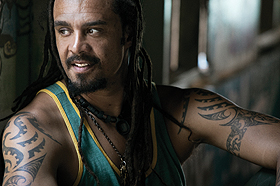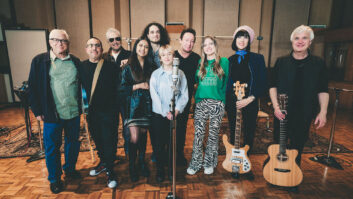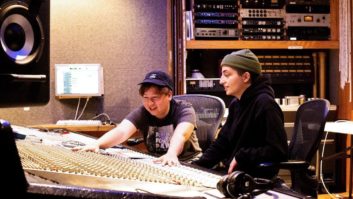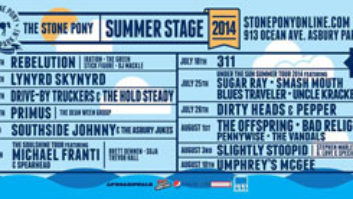
Photo: James Minchin
Offhand, Michael Franti and Spearhead would not seem to be likely candidates to land songs in the Top 20 and become a popular headliner. After all, the tall, biracial, dreadlocked, tattooed, perennially barefoot Franti has been dancing (literally) around the periphery of what we might call “popular” music since the mid-’80s. He’s produced an impressively eclectic body of work that fuses hip-hop, funk, folk, reggae, ska, rock, soul and other styles, and he’s never shied away from the strong political convictions and social consciousness that drives much of his work. With pointed lyrics addressing the death penalty, police brutality, poverty, AIDS, corrupt government and other hot-button issues, Franti could easily have been dismissed as merely an activist firebrand by now—were it not for the fact that he also writes beautiful love songs, radiates optimism and goodwill onstage and off, and has come up with some of the catchiest tunes you’ll hear on the radio. As this article is being written in late August, the irresistible title track of Franti and Spearhead’s new album, The Sound of Sunshine (released September 21), is the Number One song on Triple-A radio and seems likely to follow last year’s smash hit, “Say Hey (I Love You)” onto the pop singles chart.
The Top 20 success of “Say Hey” caught everyone, including Franti, by surprise. “It was a year after the record had been released,” he says over lunch in San Francisco (where he lives). “‘Say Hey’ had already had its run at Triple-A radio and gone away, but then some Top 40 stations started playing it the next summer—one in Salt Lake, another in Green Bay, one in Florida. Then the focus groups got a hold of it and liked it, so all these other stations picked it up. Next thing you know, it’s everywhere and it’s a hit. It was wild!
“The week it went crazy, my appendix ruptured and I went into the hospital,” he continues. “I almost died. But I said to the doctor, ‘You better help me survive this because I want to hear my song on the radio!’” Franti survived, of course, and got his wish when he heard ‘Say Hey’ on the radio in the car the day he was released from the hospital. The song became inescapable; a summer later it still is—it’s appeared in a film, a videogame and now it’s the soundtrack for a ubiquitous Corona Light (beer) commercial.
Franti says that his brush with mortality informed the songwriting for The Sound of Sunshine, which is easily his most buoyant and affirmative disc to date. “I know there are a lot of people hurting out there right now,” he says, “and if our music can bring them some peace and some sunshine…” He lets out a little self-conscious laugh, as if he doesn’t want to sound like he’s just promoting the album. The songs are still dotted with socially aware sentiments, and in his offstage life, Franti is as involved with good deeds as ever, such as his annual free Power to the Peaceful festival in San Francisco, which challenges the thousands who attend to better the world and their communities, and his involvement with Sole4Souls, who distribute free footwear to the needy around the world. But he is conscious not to sound heavy-handed or didactic, and these days he wants people to sing along and shake their bones, as well as think.
Through the years, Franti has recorded in many different studios, some in his native Northern California, but also in Philadelphia (early work with hitmaker Joe “The Butcher” Nicolo at Studio 4) and Jamaica; the excellent 2008 All Rebel Rockers album, which contained “Say Hey,” was mostly cut at Anchor Studios in Jamaica with reggae legends Sly and Robbie co-producing. One song from Anchor featuring Jamaican musicians appears on The Sound of Sunshine: the bouncy dancehall number “Shake It,” featuring Lady Saw. But the rest of the album—a wonderful blend of breezy and anthemic rockers, heartfelt ballads and Caribbean-influenced numbers—has a more unusual provenance. It was largely recorded in backstage dressing rooms and hotel rooms during Spearhead’s 2010 winter and spring tour supporting John Mayer in basketball and hockey arenas, and in Franti’s small bedroom at home in San Francisco. (A couple of tunes were begun in his remote villa/yoga retreat in Bali, too.)

Michael Franti (seated) working on material for The Sound of Sunshine with musician/engineer Jay Bowman in the Hotel Arts in Calgary, Alberta, Canada.
Photo: Ben Renschen
“We’d play a lot of the new songs every night and then we had a Pro Tools rig and a laptop that we would take into the dressing room, and we would attempt to record the songs based on how we saw people respond to them—are they dancing, are they singing along, are they responding at the right points in the music? So Jay [Bowman, co-songwriter, guitarist in the band, engineer] and I would set up and re-record them—speed ’em up, slow ’em down.” Adds Bowman, “literally within moments of performing them because the tempos were fresh in our minds. It was a great field test.”
“Jay and I and our bass player, Carl Young—‘the godfather’—write most of the songs,” Franti says. “So usually what will happen is it might start with a little guitar riff or a chord progression or a hook. I always try to come up with the hook of the song first. I’ve written songs where you write the whole song and there’s nothing to sing along to, you’re struggling to find that hook. So it’s more productive to write the sing-along part first. Then we’ll put up a little beat on the drum machine and make a basic demo.”
Bowman notes, “We do have a studio here in San Francisco—the Sugar Shack—but it’s more like the Storage Shack these days,” he says with a laugh. “We got tired of being in dark rooms, so with laptop technology you can pretty much be anywhere. It was all over once we started using the laptop. We started working in Michael’s room on the laptop, and I thought, ‘We have an HD rig sitting over at the Shack—let’s bring it over here and set it up in the bedroom. We can do it all in here, even mixes.’ So we’ve done a lot there and we also took it out on the road with us.”
Bowman first encountered Franti at Hyde Street Studios (San Francisco) in 2003 when Franti was recording his album Everyone Deserves Music. During the sessions for that record, Bowman was asked to come help out at the Sugar Shack on a version of “Bomb the World” that was being produced by Sly and Robbie, and he and Franti forged a friendship that later blossomed into a creative partnership. Bowman co-wrote nine of the 11 songs on Sound of Sunshine with Franti, and bassist Carl Young also contributed to the writing of four. The personnel in Spearhead has changed some over time, but is solid now with the previously mentioned three, plus guitarist Dave Shul, drummer Manas Itene and keyboardist Raleigh Neal. That said, not all the players appear on every track of the CD; sometimes Franti will play bass or drums, and Young or Bowman keyboards. Sultry singer Jolene Rust is also on the album and tours with the band.

Franti, too, knows a fair amount about recording, having been involved in the production of his music since his pre-Spearhead days in Bay Area groups The Beatnigs and the Disposable Heroes of Hiphoprisy, and usually owning some home studio equipment, from 4-tracks in the early days to ADATs to Pro Tools later on. “Learning about recording was trial by fire for me,” he says. “I bought all the gear; I bought a little mixing desk, I bought samplers, I bought mics, keyboards, set up the space and then it was like, ‘How do I turn it on?’” he says with a laugh. Needless to say, he doesn’t have that problem anymore, and he credits working closely with Sly and Robbie as having taught him much about sonics and production.
Anyway you look at it, though, the recording methodology for The Sound of Sunshine was quite unorthodox. Nearly all the album was recorded using just two mics—a Neumann U87 and a Shure SM57—usually one at a time, including on drums. “Most of the drums were done in the dressing room or a hotel room, depending on how lenient they might be—‘Okay, Minas, let’s get this one really quick!’” Bowman says with a laugh. “We’d set up with one mic and we’d listen back, and say, ‘Oh, the hi-hat is too loud,’ so we’d turn the drum set a little to the other side or put the mic on the other side. ‘Oh, we’re not getting enough reverb. Okay, let’s open the bathroom door.’ ‘We’re not hearing the kick drum enough; move the mic closer.’ Sometimes the best sound came from having the mic off to the side. Then, if we needed a little more of something, we added other parts when it was convenient.” Thus, most of the drum parts were constructed after the fact from multiple tracks within Pro Tools. “Also, once it was in the box, we could send a little reverb to an aux and that gets us a stereo field,” Bowman adds.
“Once we went with this mobile route,” he continues, “we figured the one way we were going to win is to have a great, solid signal path. So we had the two mics and the laptop and then, to get a more traditional sound, I got us an API 512 [mic pre] and coupled it up with a Purple Audio MC77 [1176-style limiter], and that was our whole signal chain.”
“Everything was constantly evolving,” Franti adds. “We did dozens of different versions of songs, and finding the right groove and the right tempo often took hours and hours of experimentation. I’m a person who, at a certain point, will just say, ‘Throw it away; let’s start over!’ And then I’ll lean over to Jay: ‘Did you save that?’” he says with a laugh. Franti records his vocals throughout the process, often working alone. “I’ll have the laptop and a mic, and I’ll sing until I get it right. It might be the first take, it might be the 30th take.” He and Bowman never comp vocals per se, but Franti might do an occasional punch-in.
All along, too, “I’m always asking people for their opinions,” Franti says. “Sometimes they’ll say, ‘You know what, I liked the version before this one,’ or, ‘Maybe that last guitar part is a little bit too much,’ or, ‘The other one had a better beat to it but I can hear the words better on this one.’ We sometimes even have listening parties on our bus—invite fans onto the bus and crank some tunes up. See what they like; see when people stop dancing.”




